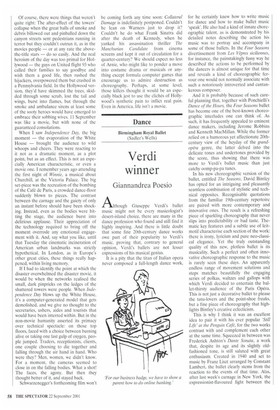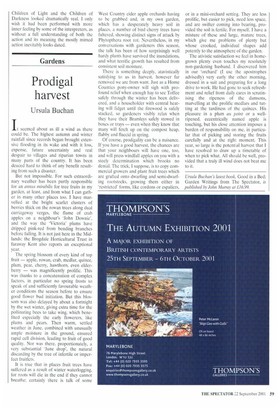Dance
Birmingham Royal Ballet (Sadler's Wells)
Verdi winner
Giannandrea Poesio
Athough Giuseppe Verdi's ballet music might not be every musicologist's desert-island choice, there are many in the dance profession who found and still find it highly inspiring. And there is little doubt that some fine 20th-century dance works owe part of their popularity to Verdi's music, proving that, contrary to general opinion, Verdi's ballets are not lesser expressions of his musical genius.
It is a pity that the titan of Italian opera never composed a full-length dance work, for he certainly knew how to write music for dance and how to make ballet music 'speak'. He also had a kind of innate choreographic talent, as is demonstrated by his detailed notes describing the action his music was to portray and accompany in some of those ballets. In the Four Seasons divertissement from Les Vepres siciliennes, for instance, the painstakingly fussy way he described the actions to be performed by the dancers is almost unique for that time and reveals a kind of choreographic fervour one would not normally associate with such a notoriously introverted and cantankerous composer.
And it is probably because of such careful planning that, together with Ponchielli's Dance of the Hours, the Four Seasons ballet has become one of the best-known choreographic interludes one can think of. As such, it has frequently appealed to eminent dance makers, including Jerome Robbins and Kenneth MacMillan. While the former relied on a humorous yet affectionate 20thcentury view of the heyday of the grandopera genre, the latter delved into the delicate tones and undertones provided by the score, thus showing that there was more to Verdi's ballet music than just catchy oomp-pa-pa tunes.
In his new choreographic version of the ballet, entitled The Seasons, David Bintley has opted for an intriguing and pleasantly seamless combination of stylistic and technical opposites. Recognisable quotations from the familiar 19th-century repertoire are paired with more contemporary and innovative ones. The result is a refreshing piece of sparkling choreography that never slips into predictability or bad taste. Thematic key features and a subtle use of leitmotif characterise each section of the work: there is irony, lyricism and pure neo-classical elegance. Yet the truly outstanding quality of this new, plotless ballet is its musicality. Such a perfect and often innovative choreographic response to the music is rarely seen these days. An apparently endless range of movement solutions and steps matches beautifully the engaging series of polkas, waltzes and gallops with which Verdi decided to entertain the ballet-thirsty audience of the Paris Opera. This is not just a decorative ballet to please the tutu-lovers and the point-shoe freaks, but a fine piece of choreography that highlights Bintley's creative eclecticism.
This is why I think it was an excellent idea to pair it with his ever popular 'Still Life' at the Penguin Café, for the two works contrast with and complement each other at the same time. Squeezed in between was Frederick Ashton's Dante Sonata, a work that, despite its age and its slightly oldfashioned tone, is still saluted with great enthusiasm. Created in 1940 and set to music by Franz Liszt arranged by Constant Lambert, the ballet clearly stems from the reaction to the events of that time. Alas, after last week's carnage in New York, the expressionist-flavoured fight between the Children of Light and the Children of Darkness looked dramatically real. I only wish it had been performed with more inner feeling by some of the interpreters, as without a full understanding of both the action and its meaning the mostly mimed action inevitably looks dated.











































































 Previous page
Previous page